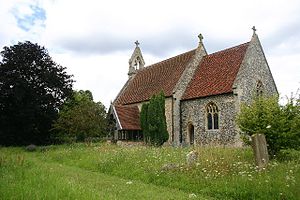- All Saints Church, Wordwell
-
All Saints Church, Wordwell 
All Saints Church, Wordwell, from the southeastLocation in Suffolk Coordinates: 52°18′58″N 0°40′50″E / 52.3160°N 0.6805°E OS grid reference TL 828 720 Location Wordwell, Suffolk Country England Denomination Anglican Website Churches Conservation Trust Architecture Functional status Redundant Heritage designation Grade I Designated 14 July 1955 Architect(s) S. S. Teulon (restoration) Architectural type Church Style Norman, Gothic, Gothic Revival Completed 1866 Specifications Materials Flint, tiled roofs, timber porch All Saints Church, Wordwell, is a redundant Anglican church in the village of Wordwell, Suffolk, England. It has been designated by English Heritage as a Grade I listed building,[1] and is under the care of the Churches Conservation Trust.[2] It stands in a small community alongside the B1106 road between Bury St Edmunds and Brandon.[3]
Contents
History
The church dates from about 1100. During the 14th and 15th centuries new windows were installed to replace the 12th-century lancet windows. A porch was added in about 1500. By 1757 the church was in a "run down" condition, but it had been "put into good order" by 1829. Later in the 19th century a restoration was carried out between 1857 and 1866 by S. S. Teulon. This included work on the west front, the bellcote, the porch, the priest's doorway, the roofs, the pulpit and the reredos.[3]
Architecture
Exterior
All Saints is constructed in flint rubble, with freestone dressings. The roofs are tiled, and the porch is timber. Its plan is simple, consisting of a nave with a south porch, a chancel, and a bellcote at the west end.[1] The church contains Norman features,[3] while the windows added later are in Decorated style.[1] The north and south doorways are Norman with round-headed arches; they are identical in form, and have Saxon influences. The tympanum of the south doorway contains a pair of lions with dog-like features surrounded by foliage. The north doorway is blocked, and its tympanum contains two human figures, one holding a ring. There is a grid-like object between them.[1][3] It has been suggested that they represent Saint Catherine and her wheel, and Saint Lawrence with a gridiron.[1]
Interior
The chancel arch is also Norman, as is the circular font. The benches date from the 15th century and have carvings. All the bench ends have poppyheads. Some of the benches have additional carvings, including representations of animals. One bench is carved on its back with wild boars, and figures having human faces but animal bodies. The rest of the fittings date from the 1888 restoration.[1]
See also
- List of churches preserved by the Churches Conservation Trust in the East of England
References
- ^ a b c d e f "Church of All Saints, Wordwell", Heritage Gateway website (Heritage Gateway (English Heritage, Institute of Historic Building Conservation and ALGAO:England)), 2006, http://www.heritagegateway.org.uk/Gateway/Results_Single.aspx?uid=284186&resourceID=5, retrieved 12 December 2010
- ^ All Saints' Church, Wordwell, Suffolk, Churches Conservation Trust, http://www.visitchurches.org.uk/Ourchurches/Completelistofchurches/All-Saints-Church-Wordwell-Suffolk/, retrieved 24 March 2011
- ^ a b c d Baxter, Ron (2008), All Saints, Wordwell, Suffolk, Corpus of Romanesque Sculpture in Britain and Ireland, http://www.crsbi.ac.uk/search/county/site/ed-sf-wordw.html, retrieved 12 December 2010
Categories:- Grade I listed buildings in Suffolk
- Grade I listed churches
- Church of England churches in Suffolk
- Norman architecture
- English Gothic architecture
- Gothic Revival architecture in England
- Religious buildings completed in 1866
- Churches preserved by the Churches Conservation Trust
Wikimedia Foundation. 2010.

